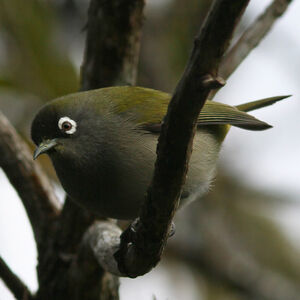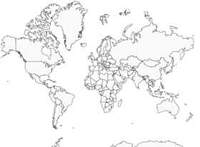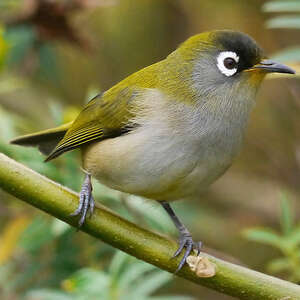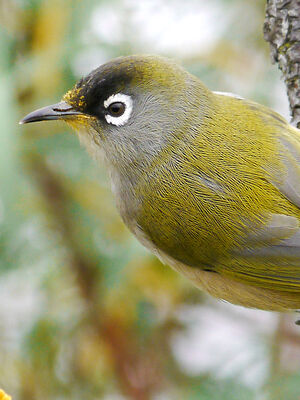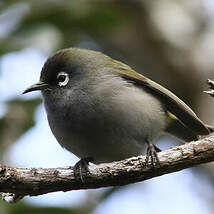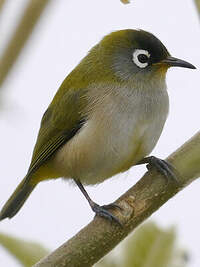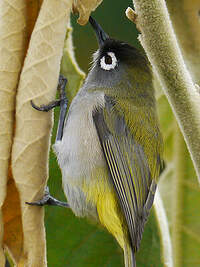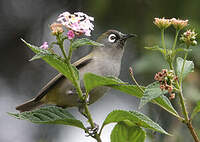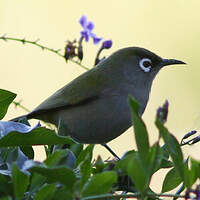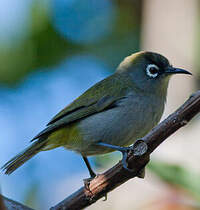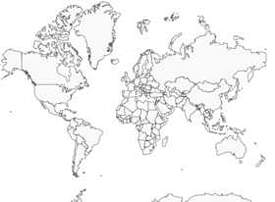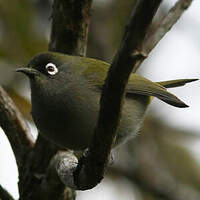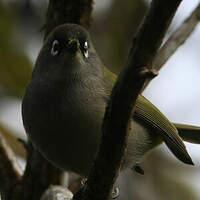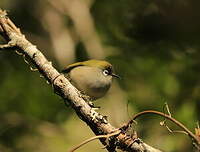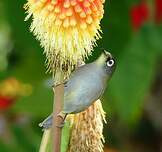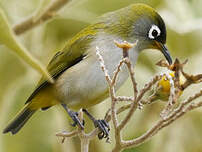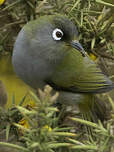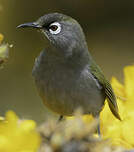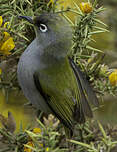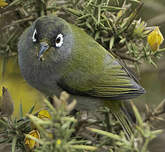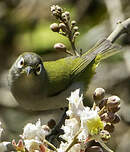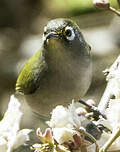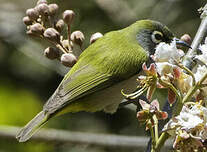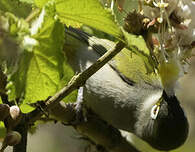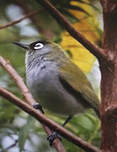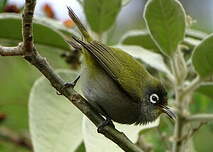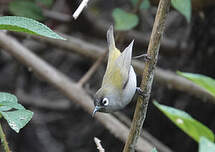Reunion Olive White-eye
Zosterops olivaceus - Zostérops de la Réunion
Identification
Two species of Reunion Olive White-eye are present on Reunion Island among the 84 species existing world-wide, both of them being endemic. This is the Reunion Olive White-eye which the locals refer to as the 'Zoizo Vert'. Indeed, it differs from the Grey-headed Reunion Olive White-eye in having a green colouration starting from the neck and spreading to the sides of the neck and back down to the tail. The remiges and rectrices are darker but have pale yellow-green edging that resemble the bird's upper side. The Reunion Olive White-eye is also called the Zoizo Lunette due to its bright, white orbital ring, shared by almost all members of the white-eye family. The forehead and lores are black, the postoculars are grey and the throat and chest are also grey. The flanks and lower abdomen are buff with yellow in the middle of the abdomen and the chin is yellow. Its eye iris is brown, the slender curved beak and legs are dark and there is no sexual dimorphism in this species. The juvenile has no white orbital ring.
Subspecific information monotypic species
Foreign names
- Zostérops de la Réunion,
- Anteojitos oliváceo de Reunión,
- olho-branco-oliváceo-da-reunião,
- Réunion-Olivbrillenvogel,
- olajzöld pápaszemesmadár,
- Olijfgroene Réunionbrilvogel,
- Occhialino di Reunion,
- réunionglasögonfågel,
- Grønngumpbrillefugl,
- okánik olivový,
- kruhoočko olivové,
- Réunionbrillefugl,
- reunioninrilli,
- zostèrops de l'illa de la Reunió,
- szlarnik krzywodzioby,
- Оливковая белоглазка,
- レユニオンメジロ,
- 橄揽绣眼鸟,
- réunionglasögonfågel,
- 留尼旺橄綠繡眼,
Voice song and call
Habitat
The Reunion Olive White-eye is a forest bird, frequenting middle and high altitude rain forests up to 2,500 meters. It is visible in the entire Réunion National Park and the Bélouve Forest. In winter it moves down into exotic vegetation. It is easier to encounter it near flowering zones or around citrus groves.
Behaviour character trait
The Reunion Olive White-eye is a bird known for its sociability. Nevertheless, it is easily found in small groups participating in bird circles alongside the Reunion Grey White-eye, another endemic species.
To feed itself, it moves from tree to tree uttering faint, high-pitched cries, mainly on Hypericum lanceolatum, a native shrub of Reunion. It sucks the nectar of these flowers due to its thin and curved beak. It approaches flowers head-on or at an angle, puncturing the base of the flower. It sometimes shreds the leaves of Solanum mauritianum, locally called bringelle marron or tabac marron, but for what reason remains uncertain.Dietfeeding habits
Reproduction nesting
The Reunion Olive White-eye is monogamous. It breeds during the Southern Hemisphere summer. The cup-shaped nest is built at the end of a horizontal branch or in the fork of a tree at 1 or 2 meters from the ground. The outside of the nest, between 70 and 75mm, is made of thin twigs, the inside, with a diameter of 40 to 45 mm, is lined with moss and down. The female lays two pale blue eggs.
Geographic range
Threats - protection
IUCN conservation status
concern
in the Wild
threatened
evaluated
The Reunion Olive White-eye is generally not threatened, but it is difficult to establish a trend because the impacts of habitat modification on this species are unknown today. Endemic to Reunion, it is protected by the ministerial order of February 17, 1989. Hunting, capture or sale are totally prohibited and are considered a criminal offence punishable by a prison sentence and a large fine.
Sources of information
- IOC World Bird List (v15.1), Gill, F and D Donsker (Eds). 2025-12-07.
- Oiseaux des iles de l'océan Indien, Langrand Olivier, ian Sinclair
- The Birds of Africa Vol VIII : The Malagasy Region, Safford R. et Hawkins F.
- BirdLife International, BirdLife International
- Société d'Etudes Ornithologiques de la Réunion ,
Other sources of interest
 Specification sheet created on
25/07/2023 by Nathalie Santa Maria
Specification sheet created on
25/07/2023 by Nathalie Santa MariaTranslation by AI Oiseaux.net
© 1996-2025 Oiseaux.net
- Accipitriformes
- Aegotheliformes
- Anseriformes
- Apodiformes
- Apterygiformes
- Bucerotiformes
- Caprimulgiformes
- Cariamiformes
- Casuariiformes
- Charadriiformes
- Ciconiiformes
- Coliiformes
- Columbiformes
- Coraciiformes
- Cuculiformes
- Eurypygiformes
- Falconiformes
- Galliformes
- Gaviiformes
- Gruiformes
- Leptosomiformes
- Mesitornithiformes
- Musophagiformes
- Nyctibiiformes
- Opisthocomiformes
- Otidiformes
- Passeriformes
- Pelecaniformes
- Phaethontiformes
- Phoenicopteriformes
- Piciformes
- Podargiformes
- Podicipediformes
- Procellariiformes
- Psittaciformes
- Pterocliformes
- Rheiformes
- Sphenisciformes
- Steatornithiformes
- Strigiformes
- Struthioniformes
- Suliformes
- Tinamiformes
- Trogoniformes

